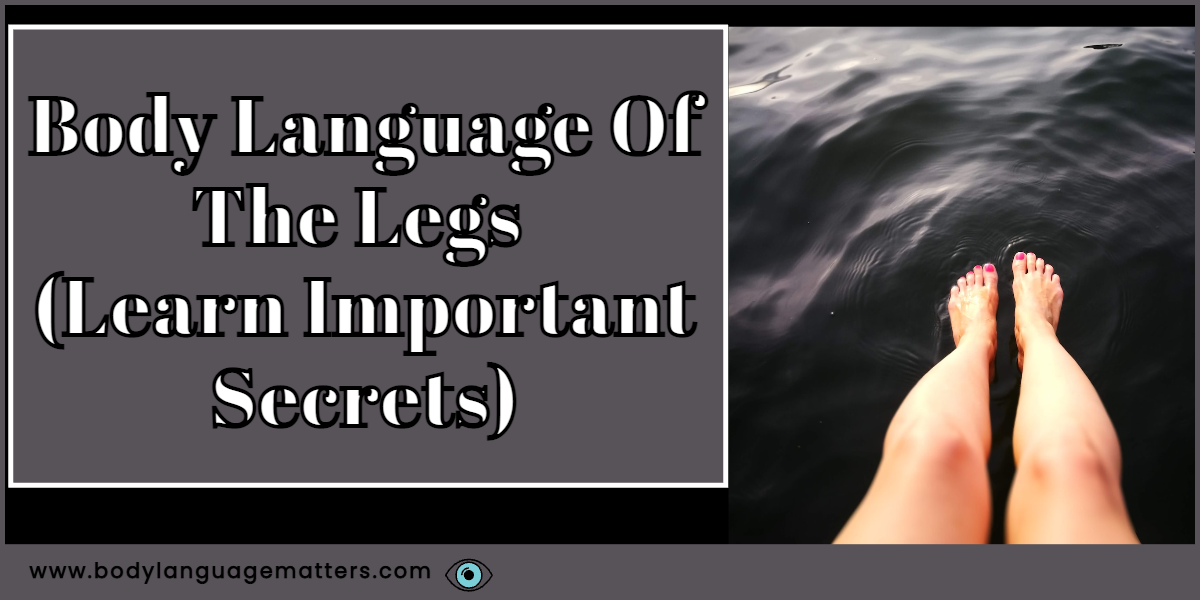Body language is the expression of attitudes or feelings through body movements or gestures. Our posture, our facial expressions, our hand gestures, and even our eyes can convey how we are feeling.
But the most important aspect of body language to remember is that it can tell others what we are feeling without us having to say a word.
The human body has over 7000 nerve cells that send messages about how you are feeling to other people either by posture or expression.
Leg movement is often overlooked as a nonverbal cue, but the legs can communicate a lot of information. From elegance to nervousness to joy, the legs transmit a wide variety of emotions.
They also function as an adaptive survival tool and can tell if someone intends to attack you, which provides honesty in their communication.
Your legs are no exception! When you are sitting down with your knees open, it might mean that you are receptive and eager to communicate with others – but when you cross them, this may signal an attempt at self-protection and an unwillingness to engage in conversation.
Table Of Content Body Language Of The Legs
- What is context in body language terms
- What does legs apart mean in body language
- What does spatial distancing mean in body language
- Body language legs pointing meaning
- What does a territorial stance mean in body language
- What does a territorial challenge mean in body language
- Why do we stand at an angle when we speak to someone
- Body language legs position meaning
- What are walking behaviors in body language
- Setting the pace during walking what does it mean
- Body language legs standing meaning
- Body language legs splayed meaning
- Body language legs up in the air meaning
- Body language legs on table meaning
- Body language legs stretched out meaning
- Body language legs wrapped around
- Shaking legs while sitting body language
- How to stand correctly with your Legs
- What does ankles locking mean in body language
- What do ankles locking around a char leg mean
- What does “knee-high self-hugging” mean in body language
- What doe’s rubbing someone’s legs mean
- Why do guys shake their legs when sitting down
- What does it mean when a woman stands with her legs apart
- What does bouncing legs mean in body language
- What does leg cleansing in body language mean
- Hands between legs body language
- Sitting with a leg tucked under body language
- Summary
It’s important to understand how to read body language of the legs to get the correct information when analyzing anyone.
One of the first things we must understand when reading people’s nonverbal cues is context.
What is context in body language terms.

Context is everything you see in the environment when you are looking at somebody. For example, when somebody is talking to a boss, the context of the conversation is very different from when they are speaking with a family member.
So when we analyze anyone, we need to think about who is in the room, what the conversation is about, what they’re doing there, and how they look in general.
Understand the environment first.
The environment a person lives in can give us clues to their thoughts & feelings. For example, if they’ve been under stress from the environment around them, they will have certain ways of showing emotion or concern.
Who are they talking to?
Before you talk to someone, it’s important to know who they are and if they would feel comfortable around you or not. Different people will have a different level of comfort with a stranger vs. an old friend, for example.
They might feel more comfortable talking with friends than strangers because they know them better.
If they are a police officer, they will act differently from how they would behave when talking to their work colleague who they know well.
You should start to see how context helps us understand what the person is going through in order to get a good read of their body language.
The next thing we need to do is baseline the person we are reading. Some argue that this should come first, however, it is irrelevant. We just need to do it.
What is a baseline?

In simple terms, a baseline is how a person behaves when they’re not under any stress.
There really is no big secret to getting a baseline.
We just need to observe them in their regular day-to-day environment and, if we can’t do that, we need to ask simple questions that will help them relax and feel more confident.
Once they’re feeling more prepared then we can proceed to look out for any shifts to their body language.
The best way to get a good read on anyone is to read nonverbal head movements in clusters.
Why read in clusters?
Reading in clusters is the best way to analyze and will give users a better understanding of what that person is really saying without them saying it.
We can’t just say head nodding is a contradiction to the conversation without seeing shifts in clusters.
An example is: When we are talking to someone and we ask a simple question they then say, yes and shake their head at the same time.
Most people with little knowledge on the topic of body language would say this is a deceptive sign. When in fact, this does not mean they are disagreeing with us, but it gives us a data point.
However, if we see the head shake and the verbal answer of “yes,” then a shift in a chair and a sharp sniff, then this would be classified as a cluster change.
We would know from this data point that something is up and we need to dig deeper or simply avoid the conversation altogether.
That is why reading in clusters is so important. There is a simple rule that all body language experts use, and that is there are no absolutes.
What does legs apart mean in body language?
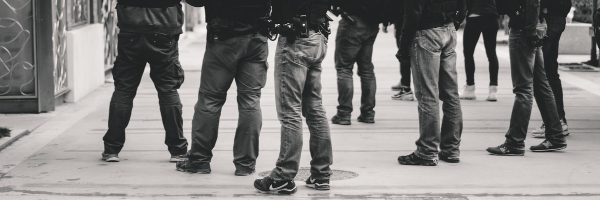
There are different types of leg positions in body language. The one that is most common among people in the workplace is the legs together position.
It’s not necessarily a bad thing, it just shows that your boundaries are up and you’re not very open to the person in front of you.
However, if someone has their legs apart it means that they are more open to the other person in the conversation and feel confident in themselves.
The territory is being claimed by displaying legs apart. It’s more common in men because territorial behavior calls for a greater physical distance between two individuals.
What does spatial distancing mean in body language?

In spatial distancing, the person is either physically or emotionally distancing themselves from you. This can be a sign of their reluctance to engage with you in a conversation.
When somebody does this, it could signal that they are not interested in what you have to say or that they are feeling overwhelmed by the present situation.
In spatial distancing, someone might lean away from you and turn their body at an angle from your direction. They might also turn their back on you and face a different direction, cross their arms in front of themselves, or fold their hands together in the space between them and their body.
Spatial distancing can also include getting up from a seated position and going further away from the person who is trying to interact with them.
Most people are comfortable when out in public with a space of around 12 – 25 feet. In a social setting like a party, the distance is 3 to 10 feet and our personal space is 1 to 4 feet.
However, we see the change in places like the London Underground, where personal space can be less than 1 foot away.
Personal space is subjected to that individual.
Body language legs pointing meaning?

- Legs pointing toward you can be seen as an invitation to talk or to get closer.
- Legs pointing away from you can be seen as wanting some space.
- Legs crossed might be interpreted as being defensive or closed off to the conversation.
The way people sit can say a lot about how they are feeling. Some common body language signals are pointed ankles, crossed legs, and pointed toes.
What does a territorial stance mean in body language?

A territorial stance is when one person stands with their arms crossed, leaning back legs spread apart, thinking police officer. This stance can be seen as a defensive and aggressive stance and may be used to intimidate the person they’re talking to.
It’s also sending a signal of confidence and subconsciously claiming territory
What does a territorial challenge mean in body language?
The territorial challenge is used by people to defend their territory. This behavior can be seen in competitive sports, between siblings, and in romantic relationships.
When a person invades your personal space, it serves to intimidate and send a signal that there may be violence ahead. Pay attention when you see someone starting to spout off with another.
The territorial challenge is often preceded by either a physical or verbal threat. This is then followed by the actual act of the challenge which could be anything from pushing someone out of way, grabbing something, or even just trying to dominate another person with their height.
The goal of the territorial challenge is to maintain control over an area or object that has been threatened by another individual.
Why do we stand at an angle when we speak to someone?

The angle at which we stand relative to another person can give off different meanings. For example, we stand to the side of them or at an angle and we are seen as less of a threat.
If we stand in front of them, it could send the signal that we are challenging them for a fight. This will trigger their internal defense process, whether they are fighting or fleeing.t.
We are not trying to dominate them or take over them in any way. We just want to stand here and feel natural.
Body language legs position meaning?

The legs are very much in contact with the ground and any change in their position could indicate that something has changed. When sitting with their legs crossed, it suggests that they are very much at ease and possibly content with where they are sitting or how they feel about what they are doing at that moment in time.
If someone has one leg crossed over the other while sitting, it suggests that they may be feeling uncomfortable.
They may also be feeling vulnerable because this position interrupts their balance and could put them off balance if someone were to approach them from behind or stand up suddenly next to them. They may also feel vulnerable when you see the legs close together.
Pay attention to the legs as they often go overlooked when we study or read non-verbal communication.
What are walking behaviors in body language?
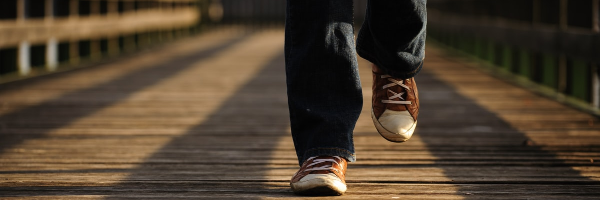
The way an individual walks can tell a lot about their mood or feelings. There are various walking behaviors in body language that are associated with different moods.
For example, if someone’s walking is fast and hurried, they might be feeling anxious or stressed.
Similarly, someone who is walking slowly with their shoulders slumped might be feeling sad or depressed.
I often see managers walking quickly to show importance or dominance, sending the signal that they’re too busy to talk to you.
Setting the pace during walking what does it mean?
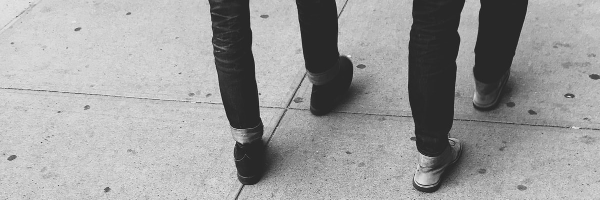
The walk rate is the number of steps taken per minute. It varies depending on the type of walking that is being done.
One thing to keep in mind when reading body language is that whoever sets the walking pace in a group is typically the one in charge. For example, we’ll speed up or slow down for the most senior person in a group.
Remember, the one who sets the pace is in charge.
Body language legs standing meaning?

The way humans communicate is through language, but there are other forms of communication that may be more powerful than words. One of them is body language.
Body language can express emotions and even complete thoughts. When someone is nervous, they might cross their legs or keep them close to their chest to feel more secure think knee clasping.
Alternatively, when someone feels confident they might try to make themselves seem taller by standing up straight with their legs apart and their hands on their hips.
When it comes to sitting behavior and we want to impress someone or get along with them, a simple rule to follow is to mirror them.
Body language legs splayed meaning?
We often make assumptions about people based on their body language. In the case of the person spreading their legs, it typically means they are feeling comfortable with you or feel confident in themselves.
Body language legs up in the air meaning?

Legs up in the air meaning can be interpreted as being bored, feeling scared, feeling relaxed, feeling shy, or just being lazy.
The key to understanding legs up in the air is context and reading what came before or after. It’s hard to call without seeing where the legs go and what else is going on within the context.
Body language legs on table meaning?
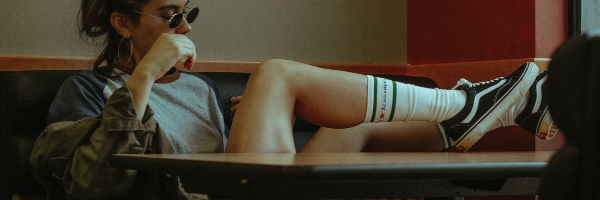
When someone puts their legs up on a table while sitting on the floor or on an available chair it means that they are feeling relaxed and comfortable in the setting.
If you see your boss doing this, it means they’re in control and this is their territory.
Body language legs stretched out meaning?

Someone stretching their legs out can have multiple meanings. They might be about to get up signaling its time to move.
It could also show that they aren’t feeling threatened and feel at ease enough with where they’re sitting, to put their feet outstretched in front of them.
Again, context is key to understanding the meaning behind the stretched-out legs.
Body language legs wrapped around?
Legs wrapped around someone are often used as a sign of love and attachment. This can be seen in children who want their mother or father’s attention. It also shows that someone wants to feel safe or protected by the other person.
Shaking legs while sitting body language?

People shake their legs while sitting to regulate themselves. This is because the leg shaking helps them to discharge excess energy. Some people might do it because of a nervous habit or because they feel nervous.
In some cultures, shaking the legs is considered to be a sign of disrespect, which could result in social difficulties or even conflict.
In Asian cultures shaking the legs while sitting is often considered an insult because it means that someone has something important to say but they are too scared to say it.
How to stand correctly with your Legs?

Keeping your back straight and your feet hip-width apart, place your hands on your hips. This is your starting position.
From this position, you can move in any of the four directions by bending one leg while keeping the other leg straight.
Standing correctly, also called standing tall, will send a clear signal of confidence to others. I experimented with this for a few weeks and it does send that confidence signal to others.
They become aware of you as you enter a room and as they talk to you. Try it out to see for yourself.
What does ankles locking mean in body language?
Ankle locking is a body language technique in which an individual’s feet and ankles are crossed in one direction and the upper foot and ankle are pointed outward in the opposite direction.
This pose typically signifies tension, restating themselves, expressing reservation or showing hesitation.
It can also be seen when someone disagrees with something they’ve said or when an opinion is shared in a group that they don’t agree with.
It’s subtle body language cues but one to look out for in conversation.
What do ankles locking around a char leg mean?
We see the ankles locking around a chair when a person feels insecure, in fear, or concerned with something going on. It’s a way of locking down the body to one space.
If you see someone locking their ankles around a chair after a question has been asked, it’s a good indicator that something is wrong and worth digging into a little more.
However, it could simply mean that’s their normal way of sitting. Context is key here.
What does “knee-high self-hugging” mean in body language?

The term “knee-high self-hugging” in body language refers to when one’s arms cross in front of the chest and form a hug.
This term is used to describe how an individual might put their arms when they are feeling vulnerable, guilty, or helpless.
Think about the last time you saw someone hugging their needs. What do you think it meant?
What doe’s rubbing someone’s legs mean?
What doe’s rubbing someone’s legs mean?
It depends on the contact it can be to show affection or it can be more provocative. Contact is important when it comes to rubbing someone’s legs.
Why do guys shake their legs when sitting down?
Leg shaking is often due to anxiety or nervousness. It is a way of calming themselves down or passive-aggressively making themselves feel better in the situation they are in.
What does it mean when a woman stands with her legs apart?

A woman standing with her legs apart is often interpreted as being sexually suggestive. The wide stance creates the illusion of a more curvaceous figure, which draws attention to the wearer’s thighs, hips, and pelvis.
It has been suggested that men may subconsciously interpret the display as a sign of sexual availability and feel more inclined to pursue her.
This might be why they are more likely to believe that they are in control of the situation and are confident.
What does bouncing legs mean in body language?
- Bouncing legs can be a sign of boredom.
- Leg bouncing is also often seen in people who are trying to focus.
- Some people do it because they are nervous or scared.
- Bouncing legs can be a sign of boredom. Leg bouncing is also often seen in people who are trying to focus. Some people do it because they are nervous or scared.
What does leg cleansing in body language mean?
Leg cleansing in body language means that you feel anxious and stressed and it is a sign that something is bothering or making you feel uncomfortable.
Hands between legs body language?
If they are rubbing their hands between their legs, they could simply be cold. This can sometimes happen when people are feeling emotional, too.
Sitting with a leg tucked under body language?
Sitting with your leg tucked under your body can signal a sense of discomfort. It can also be used as a way to shield the body from harm, such as in the example below:
Final Thoughts.

The body language of the legs is a great way to read anyone’s nonverbal cues. Most people are unaware that their legs are betraying them in conversation. That’s because they don’t think to control them as much as the arms and face.
But one thing that is hard to hide are the legs since they provide some of the best clues. We hope you have found the answer to your questions for more information on the topic check out
Female Body Language Feet And Legs (Full Guide)
